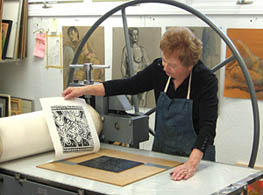 Marion Wilner in her studio. |
Carving in Wood and Printmaking
"I have always marveled at the endurance of the human spirit. My desire to visualize this universal experience has found its focus in the Old Testament Book of Exodus. Doing research on symbols from antiquity, I was attracted to the oldest Hebraic art from the Roman and Byzantine periods, as well as 14th century illuminated manuscripts. I felt compelled to reinvent and make these images my own." "As wood was the material used for the earliest form of printmaking, I felt it was emotionally and intellectually suited to the subject. I enjoy the process of carving the woodblock and printing editions which make these prints available to a wide audience." |
| Definition: A woodcut is the technique of making a relief print from a block of wood. The artist draws an image on the block and cuts all the negative space leaving raised sections. These remaining shapes are then inked with a brayer and pressed onto paper. The cut away parts do not receive ink and remain white. The resulting prints are characterized by bold contrasts between light and dark. |  |
 |
History: Woodcut is the oldest technique known for making prints. It was used in 5th century China and developed in Europe in the early 15th century. Albrecht Durer's woodcuts served as illustrations in the early days of printed books but lost ground to line engraving. In the late 19 and early 20th century artists such as Edvard Munch, Paul Gauguin and the German Expressionists rediscovered the potential of woodcuts as a medium of original artistic expression. Japanese woodcuts have also played an important role in western art. |
| Process: There are three basic steps to making woodcuts: Drawing, Cutting and Printing. To produce the "Exodus" image, Marion Wilner has reversed and transferred her drawing from paper to a birch wood block. Seated at a drawing table with the block securely placed on a bench hook, she begins to cut away all those lines and areas not required in the finished print. It is important to use a well sharpened knife and a few gouges. She favors the "V" gouge, the "U" gouge and the "C" gouge, all found in standard sets. She also finds specialized miniature gouges useful. | 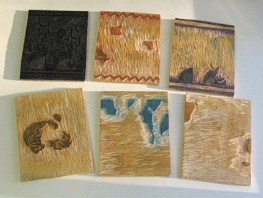 |
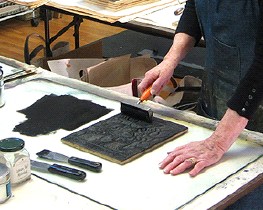 |
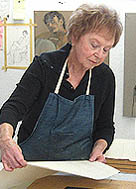 |
After the block is carved, Wilner brushes it well and sets it on the glass countertop to be inked. She prefers oil based inks and rubber brayers. The ink is rolled on until the entire block is evenly coated. On the press bed is a registration frame Wilner has made for this block. Kitikata, a Japanese paper is carefully laid over the inked block, covered with padding blankets and run through the press with appropriate pressure. Uncover, gently remove the paper and, "Voila!" You have a print. All the work of each stage has been rewarded. |
|
The resulting image... "While conducting research on symbols from antiquity for this "Exodus" series, I was attracted to the oldest Hebraic art from the Roman and Byzantine periods, as well as from 14th century illuminated manuscripts. I felt compelled to reinvent and make these images my own." |
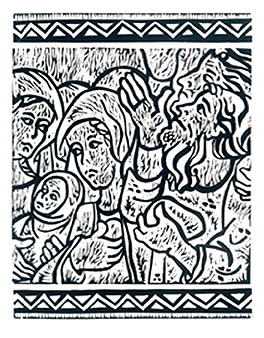 'Exodus III' - 8.5 X 11" - Woodcut |
Original works, images and content © 2007 - 2015 Marion Wilner. All rights reserved.
